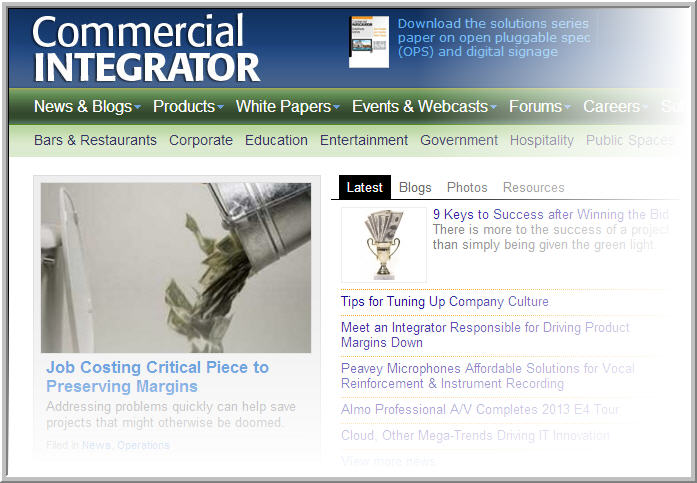Addressing problems quickly can help save projects that might otherwise be doomed.
November 18, 2013 | by D. Craig MacCormack Commercial Integrator Magazine
If you’ve been victimized by a profit-sucking job that spiraled out of control before you knew what had happened and had to resort to correcting your procedural mistakes before the next job rather than addressing them before the problem worsened, there is hope.
In his NSCA Best Practices Conference session “Job Costing: An Execution Guide for Operations,” Solutions360 president and CEO Brad Dempsey taught attendees some of the ways to recognize and fix potential pitfalls before they become worse immediately.
Click here to read the article at Commercial Integrator
“You need to monitor your projects and make changes while there’s still time to do something about it,” he says. “It’s not just about doing something different or better on the next project. Job costing is typically thought of as an accounting function, but margins are getting tighter, so moving some of those functions can increase efficiency.
“Job costing is about managing your gross margins and looking at how that affects your jobs. Accountants look at numbers in the rearview mirror, but managers need to use numbers to look ahead. The people who can make changes are the ones with feet on the ground.”
All aspects of job costing can be tied back to four gross percentages: budget, current projection, invoicing position (actuals) and earned, he says.
“A project is a financial entity,” says Dempsey. “If you don’t do it well, there’s no real point in doing it at all. You can look at your past performance to get sharper. If you watch these (four GPs), the job won’t go sideways without you knowing when or why.”
Dempsey advises an addendum to the long-held business principle of “bill early, bill often (BEBO)”: bill accurately, which would make the acronym BEBOBA.
“Understanding gross margins per hour can help you understand if you should take the job in the first place,” he says. “Your capacity for work is based on your labor force. Banks don’t want to see revenue go up and down wildly from month to month.”
Banks also keep a close eye on a company’s backlog, he says.
It’s important for installers to compare the current projection for a project cost to the budget for that project, says Dempsey. That can tell you what’s changed, why it changed and how it affects the job. Most AV and construction jobs employ the cost-to-cost revenue recognition model, he says, which divides the actual cost of the project by the estimated cost to determine when the job is complete.
Managers should always err on the side of overbilling whenever possible because that means “we’re using the customer’s money and are in a positive cash position.” Under-billing companies find themselves using their own resources and in a negative cash position.
Billing frequency is one of the first things you should discuss with a client, says Dempsey.
“Your overbilling and underbilling position is a good indicator of whether there are problems on the job,” he says.
When it comes to material and burden, or other billing aspects, the most important thing is to make sure everyone in your company follows the same rules, says Dempsey.
“Other companies may calculate margins differently than you do, but it’s important for you to calculate consistently,” he says.
Click here to read the article at Commercial Integrator
About the author: D. Craig MacCormack

